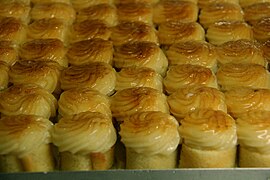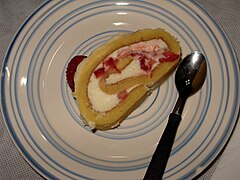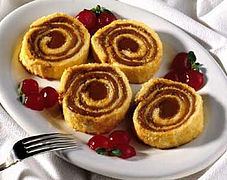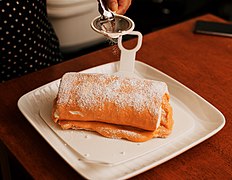Pionono
-
 Media: Pionono
Media: Pionono
Pionono describes different sweet or savory pastries from Granada, Spain, the Philippines, South America, and the Caribbean. It is named after Pope Pius IX's name in Spanish, Pío Nono.[1][2]
By country
Spain
Piononos are small pastries traditional in Santa Fe, a small town adjacent to the city of Granada, Spain. A pionono has two parts: a thin layer of pastry rolled into a cylinder, drenched with different kinds of syrup which give the pionono a sweet and pleasant texture, and crowned with toasted cream. It is typically eaten in one or two bites.
Philippines
In the Philippines, pionono is more commonly spelled as pianono. It is a rolled sponge cake and is more accurately a type of jelly roll. It consists of a layer of pastry made from eggs, sugar, and sifted flour baked in a sheet. Once cooled, jelly or other types of filling is spread over the pastry. It is then rolled from one end to the other. Its most common traditional filling is simply sugar and butter (or margarine), similar to the other forms of the Filipino mamón (sponge cakes). Modern versions, however, are commonly frosted and can include a variety of fillings.[3][4]
South America and Cuba
In various South American countries such as Argentina, Uruguay, Paraguay, Venezuela, Colombia, Peru and Cuba, piononos are prepared using a dough made of flour, eggs, and sugar, which is baked in a thin sheet then rolled around a filling of dulce de leche sometimes with walnuts, or fruits like strawberries with chantilly cream, or in the case of savory piononos with cured ham, cheese, tomato and mayonnaise, or a savory salad, such as ham salad with asparagus and lettuce, chicken salad or even tuna. A similar cake is called "Brazo de Gitano" or "Brazo Gitano" in Cuba, Spain, and several other Spanish-speaking countries. In Uruguay a similar preparation called massini is not rolled and its dough is filled in between with whipped cream and covered with burnt yolks.
Puerto Rico (U.S.)
In Puerto Rico, piononos are prepared using ripe, or yellow, plantains as the "bread" around a savory filling. Plantains are sliced length wise and fried to make it more pliable to wrap around the filling. Picadillo, seafood, lunch meat, or vegetables topped with cheese are typical fillings; the whole sandwich is dipped in a batter made from flour and eggs and then deep-fried or with no batter and baked.
Gallery
-
 Piononos from Málaga
Piononos from Málaga -
 Piononos from Santa Fe, Spain
Piononos from Santa Fe, Spain - Homemade Argentine piononos
- Sliced Savory Argentine pionono, with Ham, cheese, Salsa golf and vegetables
-
 Sweet Argentine piononos
Sweet Argentine piononos -
 Sliced sweet Argentine pionono
Sliced sweet Argentine pionono -
 Sweet Argentine piononos with dulce de leche
Sweet Argentine piononos with dulce de leche -

-
See also
- Brazo de Mercedes
- Swiss roll
- Yule log (cake)
- Nut roll
References
- ^ Fenix, Mickey (28 August 2014). "'Bibingka,' 'monay,' 'escandaloza' and other curious names of Philippine baked goodies". Inquirer.net. Retrieved 4 December 2014.
- ^ Ocampo, Ambeth R. (9 January 2015). "From Pius IX to 'Pio Nono'". Philippine Daily Inquirer. Retrieved 22 April 2019.
- ^ "Pianono". Ang Sarap. 28 July 2017. Retrieved 22 April 2019.
- ^ "Pianono (Filipino Sponge Cake Roll)". Kawaling Pinoy. 23 April 2018. Retrieved 22 April 2019.
External links
- Puerto Rican piononos with lobster
- Pianono
- v
- t
- e
- Alexandertorte
- Allerheiligenstriezel
- Apple strudel
- Azerbaijani pakhlava
- Bakewell pudding
- Banket
- Baklava
- Bánh pía
- Banitsa
- Bear claw
- Belokranjska povitica
- Bethmännchen
- Bierock
- Bizcocho
- Boyoz
- Briouat
- Bruttiboni
- Bulemas
- Bundevara
- Chorley cake
- Coca
- Coulibiac
- Coussin de Lyon
- Cream horn
- Cremeschnitte
- Croline
- Cronut
- Cruller
- Cuban pastry
- Curry beef turnover
- Curry puff
- Dabby-Doughs
- Dutch letter
- Eccles cake
- Empanada
- Ensaïmada
- Fa gao
- Fazuelos
- Fig roll
- Fish-shaped pastry
- Flaó
- Flia
- Flies' graveyard
- Franzbrötchen
- Gâteau Basque
- Gibanica
- Gözleme
- Gundain
- Gustavus Adolphus pastry
- Haddekuche
- Haitian patty
- Hellimli
- Heong Peng
- Huff paste
- Hwangnam-ppang
- Jachnun
- Khachapuri
- Knafeh
- Kitchener bun
- Klobásník
- Knieküchle
- Kolach
- Kroštule
- Kürtőskalács
- Lattice
- Leipziger Lerche
- London Cheesecake
- Lukhmi
- Ma'amoul
- Makroudh
- Malsouka
- Mandelkubb
- Mantecada
- Marillenknödel
- Mekitsa
- Miguelitos
- Milhojas
- Milk-cream strudel
- Mille-feuille
- Moorkop
- Mouna
- Napoleonka
- Nokul
- Öçpoçmaq
- Pain à la grecque
- Pan dulce
- Pastel
- Pastizz
- Pastry heart
- Pasty
- Pâté chaud
- Peremech
- Pirog
- Pirozhki
- Plăcintă
- Pop-Tarts
- Prekmurska gibanica
- Profiterole
- Punsch-roll
- Punschkrapfen
- Quesito
- Remonce
- Roti tissue
- Roze koek
- Runeberg torte
- Runza
- Sad cake
- Samosa
- Schaumrolle
- Schnecken
- Schneeball
- Schuxen
- Şöbiyet
- Sou
- Spritzkuchen
- Streusel
- Strudel
- Stutenkerl
- Sweetheart cake
- Tahini roll
- Toast'em Pop Ups
- Toaster pastry
- Toaster Strudel
- Tompouce
- Torpedo dessert
- Tortell
- Tortita negra
- Tu
- Turnover
- Uštipci
- Vatrushka
- Veka
- Vetkoek
- Yurla
- Zeeuwse bolus
- Žemlovka
| Chinese |
|
|---|---|
| Filipino | |
| French |
|
| Greek | |
| Indonesian | |
| Iranian | |
| Italian |
|
| Romanian | |
| Scandinavian |
|
| Swiss |
|
| Taiwanese | |
| Turkish |
topics
- Confectionery
- Crust
- Custard
- Doughnut
- Konditorei
- Kuo Yuan Ye Museum of Cake and Pastry
- List of cakes
- List of choux pastry dishes
- List of desserts
- List of fried dough foods
- List of pies, tarts and flans
- List of poppy seed pastries and dishes
- Pastry bag
- Pastry blender
- Pastry brush
- Pastry chef
- Pastry fork
- Pâtisserie
- World Pastry Cup
 Food portal
Food portal Category
Category Commons
Commons Cookbook
Cookbook WikiProject
WikiProject

























